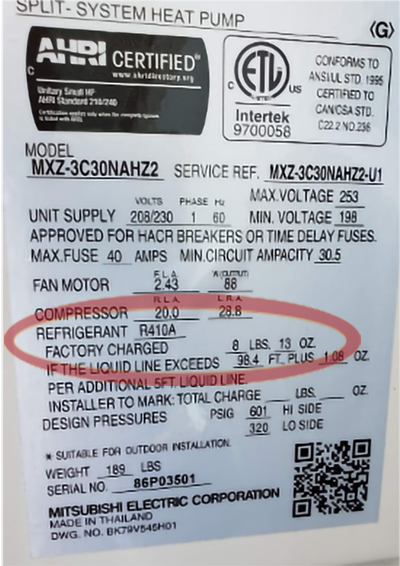What Homeowners in Warwick Need to Know About:
Refrigerant Management
Almost everyone utilizes refrigerants, and usually they help us live a comfortable, well-fed life without needing a second thought. But most of the refrigerants in use today are man-made chemicals that are very intense greenhouse gases, hundreds or thousands of times more powerful than carbon dioxide when it comes to warming the planet. And these refrigerants often leak, either when their systems are running or getting serviced or discarded. So please make note of the information on this page when planning to get rid of old refrigerant appliances, servicing things in your home that use refrigerants (your HVAC system and car AC), and buying new things with refrigerants -- and please share it with family and friends.
Appliances
When your refrigerator has reached the end of its useful life, the best way to recycle it is to contact Orange & Rockland, which as of July 2023 will pay you $25 for it and send a truck to pick it up. (Note that the refrigerator must still be working to qualify for this program.) O&R works with ARCA, which does an excellent job of recovering the refrigerants and even capturing any environmentally damaging gases that were used in the foams of older models. You can sign up for this refrigerator rebate online or by calling 866-552-3755. (In September 2023 this service was temporarily halted because of financial challenges at ARCA, but it may resume at any time.)
For other appliances with refrigerants, such as window air conditioner units, dehumidifiers, mini-fridges, or water coolers, they should be taken to one of the three transfer stations in Orange County:
21 Training Center Lane
New Hampton, NY 109589 Orr Avenue
Newburgh, NY 1255086 Tow Path Road
Port Jervis, NY 12771
Click to enlarge the map image.
For Transfer Station questions, call 845-291-2640. There is a fee of $15/unit for this service, but beyond cleaning a piece of unwanted junk out of your living space, you are also preventing the emissions of lots of greenhouse gases. If you can hold on to your appliance until next May, Sustainable Warwick will hold another Coolest Recycling Drive, where you can drop it off locally at no cost.
A typical air conditioner holds 1 pound of R410A. If emitted to the atmosphere, it would have the same greenhouse gas effect (GHG) as the emissions of driving the average car nearly 5,000 miles*, which could take you all the way from Warwick to Phoenix AZ -- and back.
*GHGs calculated using 20-year global warming potentials.
Central Air Conditioning and Heat Pumps
If your home has central air conditioning or heat pumps, the refrigerants should be handled by a technician with an EPA Type II certification. The rules are very clear that nobody is allowed to vent refrigerants. But just as many of us bend the rules by driving over the speed limit, some HVAC technicians will save time by venting refrigerants instead of properly recovering them. Hardly any of them admit they are breaking the rules, so it’s important to communicate your concerns and specifically ask to watch two common procedures while they are working for you.
Refrigerant Recovery
When an air conditioning or heat pump system is being taken out of service, the first thing to be done is to recover all of the remaining refrigerant. In some instances, the system will not be working because all of the refrigerant has leaked out, but usually there is some refrigerant left to recover. Refrigerant recovery is also performed before a full leak detection test is performed — all the refrigerant is removed before pressurizing the whole system with nitrogen.
The recovery procedure involves (image 1) connecting a refrigerant pump and recovery tank to the system via a vacuum hose, then pumping the refrigerant into the tank. The more refrigerant there is, the longer it will take, perhaps up to an hour or 90 minutes. It’s a best practice to weigh the refrigerant that has been recovered, so the recovery tank is weighed before and after the procedure to calculate the refrigerant weight. As the homeowner, you don’t need to sit and watch the entire time, but make it clear you want to see when they are starting, when they are done, and how much refrigerant is captured. (image 2) You can also ask them to let you know how much refrigerant was originally in the unit.
Pressure Testing
Before a new system is charged with refrigerant, or before refrigerant is re-charged into a system that has been checked for leaks (and hopefully had all leaks repaired), the system should be pressurized with (image 3) nitrogen, an inert gas. If the pressure drops, there must be a leak somewhere, and the leak must be fixed before refrigerant is added. If the pressure stays at the same level for a prolonged period (usually about an hour), then it is leak-tight and safe to add in refrigerant. As above, the homeowner doesn’t need to sit and watch the whole time. Ask to see the (image 4) pressure gauge when they start the pressure test, snap a picture of it when it has reached the target pressure, then check again later when they say it has passed (or failed) the test. If it has passed, the pressure gauge will be identical to when the test started. If it has failed, this doesn’t mean you have hired a poorly skilled technician. (The worst technicians would pump in refrigerant without even testing for leaks.) If it has failed, they’ll need to identify another leak, fix it, then run the pressure test again. This is all part of the process of doing a leak-tight installation.
Here's a useful training video on pressure testing air conditioners.
Automotive AC
From 1994 until the last few years, the primary refrigerant used in automotive air conditioning systems was R-134a, which is almost 4,000 times more powerful than carbon dioxide on a 20-year time frame. In recent years, this has been replaced with R-1234yf, which has an ultra-low global warming potential, but may contribute PFAS to the environment. Registered automobile repair shops should have the digital equipment to properly diagnose and recharge automotive air conditioning systems. In most cases, non-professionals should go to the pros and avoid DIY automotive A/C repairs, for both environmental reasons and to avoid creating really expensive problems.
Buying New Appliances
For up-to-date guidance on buying new appliances that use climate-friendly refrigerants plus check the box for energy efficiency, look at this resource by the Climate Friendly Cooling Campaign.
Switching to Heat Pumps
The change from heating with fossil fuels to using heat pumps is an important transition in New York State, but refrigerants leaked from heat pumps can offset part of the climate gains. When you have a heat pump installed, be sure to work with a reputable installer. EPA regulations prohibit the use of R-410A in residential heat pumps manufactured after January 1, 2025, and require the replacement refrigerants to have much lower global warming potentials. Beyond that, some European countries are already using heat pumps that have propane as the refrigerant. Propane is flammable, but it’s safe for this use because: (1) it’s in a factory-sealed unit and (2) the unit is located outside the house and no propane is circulated into the house. Also, propane has negligible greenhouse gas effects. At some point building codes in New York and the United States will allow these models here, but the timing is unclear. In short, if your heating system needs to be replaced, find a reputable heat pump installer to work with. But if you are not in a rush to replace your heating system, waiting can get you access to a system with a refrigerant that's better for the environment.
Want to learn more about refrigerant management?
To learn about refrigerant management policies in New York State, check out New Yorkers for Cool Refrigerant Management.








